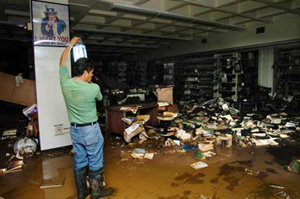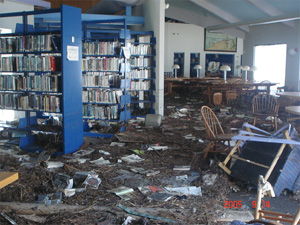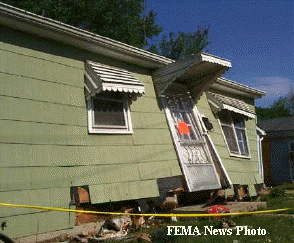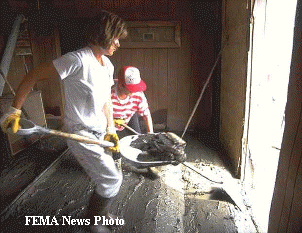Water
can come from exploding toilets, leaky roofs, or hurricane flooding, but you
should always remember that water is never just water. Depending on the cause of
the flooding and the source of the water, it may contain chemicals, pollutants,
micro-organisms, and mud. As a result, it can cause a variety of problems and
wet paper or collections may be the least of your concerns.
Before
the Flood Occurs
 Before the crisis, think about potential sources of flooding and
your susceptibility. Your plan should include components that deal with:
Before the crisis, think about potential sources of flooding and
your susceptibility. Your plan should include components that deal with:
-
moving critical equipment and collections to
safe areas,
-
obtaining supplies for pre-flood preparation
and post-flood recovery,
-
monitoring weather conditions and evacuating
staff as necessary,
-
installing flood barriers,
-
ensuring the basement sump pumps have
battery back-ups,
-
moving or anchoring buoyant equipment, such as
hot water heaters and propane tanks,
-
prioritizing salvage and cleanup activities,
and
-
determining where you can obtain temporary
services, such as water, power, and dehumidification, as well as recovery
assistance.
Your staff should be trained to deal with
flooding, by understanding how to recognize the early signs of a potential flood
event and by being able to respond with appropriate flood barriers, such as
sandbags or water diversion devices.
When a Flood is Likely
When the conditions are right for flooding in your area there are a number of
immediate steps that you should take:
-
install flood barricades, dikes, and sandbags,
-
check access roads and determine which evacuation routes are
available,
-
move critical collections, and
-
safeguard critical equipment necessary for flood recovery.
After
the Flood
 Remember
Safety. The better your plan, the less likely you'll
have significant damage; but there will always be some cleanup necessary.
Remember, the faster you perform salvage, the sooner that your collections will
be safe and the sooner your institution will be back "in business." But
human safety must always have first priority.
Remember
Safety. The better your plan, the less likely you'll
have significant damage; but there will always be some cleanup necessary.
Remember, the faster you perform salvage, the sooner that your collections will
be safe and the sooner your institution will be back "in business." But
human safety must always have first priority.
This means checking the safety of your building and its
electrical system. Be sure
that the power is cut off until a complete assessment has been made. You will
also want to be sure that the gas (if used in your institution) is shut off. If
you have a fuel oil or propane tank at your institution, it may have floated,
breaking the connecting pipes. Even an underground tank can float! Turn off
these fuel valves as well.
This also means taking care when you re-enter the structure. Don't smoke or use
any sort of open flame. In fact, it's best to only use flashlights that are
approved for use in
hazardous locations.
These don't have to be expensive - we've found
one that is only about $12.
Carefully check for falling ceiling tiles or sagging plaster or wallboard. You
may need to poke holes in the ceiling to allow it to drain. Be sure to stand
away from, not under, the ceiling and begin at the edge of the sag, gradually
poking more holes closer to the center of the sag, until the water is completely
drained. Be sure to step carefully. Water and mud make floors slippery -- and
they can hid a variety of unseen hazards. Flood waters carry a variety of
creatures, so be sure you check all closets, corners, cabinets, drawers, and
hidden spaces for animals, rodents, and snakes.
 You will likely want to be certain that you have the appropriate personal protective equipment (PPE).
This will likely include books (with steel toes and inserts to protect against
punctures), gloves (work gloves and waterproof gloves), goggles (to protect from
splashes), any maybe tyvek suits (to help keep mud and other contaminates off
your clothing). There are a number of suppliers, including
Lab Safety and
Grainger. There are a number of good
sites that provide health information related to flood situations. One is
provided by the
CDC and provides an overview of
flood recovery concerns.
You will likely want to be certain that you have the appropriate personal protective equipment (PPE).
This will likely include books (with steel toes and inserts to protect against
punctures), gloves (work gloves and waterproof gloves), goggles (to protect from
splashes), any maybe tyvek suits (to help keep mud and other contaminates off
your clothing). There are a number of suppliers, including
Lab Safety and
Grainger. There are a number of good
sites that provide health information related to flood situations. One is
provided by the
CDC and provides an overview of
flood recovery concerns.
Building Recovery.
Ventilation is the most effective way to dry out structure
interiors. While air conditioning and supplemental dehumidification work well,
they are far more expensive. Heat should not be used since it will encourage
mold growth. Open up interior doors and (if possible --
and assuming weather conditions are appropriate) exterior windows. Install high
velocity air circulators. These are heavy duty, industrial fans that are
intended to move large volumes of air on a continuous basis. Your goal will be
to keep the air moving to not only facilitate the drying out process, but to
also reduce the potential for mold.
Avoid using extension cords, if possible. If you must, ensure that the gauge of
the extension cord is appropriate for the amperage of the fan and the distance.
Always use a Ground Fault Interrupt when there is water. If you are using a
generator to power your fans, there are additional safety issues, including
grounding, carbon monoxide poisoning, and the use of gasoline. There are several
good sites devoted to generator safety -- one is by the
Consumer Products
Safety Commission and another is by an
Electric
Coop.
 Check
piers and foundations for lose of mortar,
cracking, and leaning. You may discover that you need to shore up portions of
the building. Using the assistance of a structural engineer or a licensed
contractor, support unstable building components with temporary reinforcements.
Strengthen foundations; and support floors or roofs as necessary.
Check
piers and foundations for lose of mortar,
cracking, and leaning. You may discover that you need to shore up portions of
the building. Using the assistance of a structural engineer or a licensed
contractor, support unstable building components with temporary reinforcements.
Strengthen foundations; and support floors or roofs as necessary.
Drain any
water carefully -- and slowly -- from
ground floors and basements. Make certain that the water level on the interior
doesn't fall below the water level outside or in adjacent rooms -- the resulting
pressure could cause structural failure. For basements it's best to pump the
water down several feet, mark the water level and wait 24 hours. If the water
level went back up over your mark, it is too early to drain the floodwaters.
Wait another 24 hours, pump the water down, mark the level, and wait. When the
water stops going back up, pump it down another 2 to 3 feet and again wait 24
hours. Continue this process until the water is entirely drained.
 Shovel out
mud and debris. Remove carpets and any pads (they dry very
slowly and are impossible to adequately clean). Floor covering other than
carpet, such as vinyl, may curl at the edges and the adhesive may fail. Removal
is often necessary. Other flooring, such as tile , generally survives, although
the subflooring may not dry. As a result, even seemingly stable flooring may
ultimately need to be removed. Wood flooring is also difficult to salvage, but
with slow drying you may find it possible. You will want to dry to increase air
circulation below the wood floor (in the crawl space), as well as in the
occupied space.
Shovel out
mud and debris. Remove carpets and any pads (they dry very
slowly and are impossible to adequately clean). Floor covering other than
carpet, such as vinyl, may curl at the edges and the adhesive may fail. Removal
is often necessary. Other flooring, such as tile , generally survives, although
the subflooring may not dry. As a result, even seemingly stable flooring may
ultimately need to be removed. Wood flooring is also difficult to salvage, but
with slow drying you may find it possible. You will want to dry to increase air
circulation below the wood floor (in the crawl space), as well as in the
occupied space.
Remember that
electrical circuits will need to be dried, tested, and replaced as
necessary by a licensed electrician. HVAC ducts that have been
in water will likely need to be replaced if they were flexible ducts or made
from either duct board or had internal insulation. If they are sheet metal and
have external insulation, they can be cleaned and retained. Many appliances,
such as hot water tanks and HVAC equipment, will likely need to be replaced.
Wallboard
exposed to water for more than one or two hours will likely need to be replaced.
Even if the wallboard seems to be in good condition it may be hiding pooled
water inside the walls. It is usually a good idea to remove wallboard several
feet above the flood line (wallboard wicks water up above the flood level).
This will allow the wall cavities to be dried and to have debris removed. Wet
fiberglass batt and cellulose insulation should be removed and replaced.
Styrofoam insulation usually survives floods and can generally be hosed off.
Wood timbers, like wood flooring, will need to dry slowly.
Drying plaster walls is
especially tricky. You'll need to drill holes for drying
(perhaps under moldings that you have removed) and be especially careful to dry
the plaster slowly so as to minimize damage to its keys.
Never install new materials until the entire structure is
completely dry. There is no "rule of thumb." In fact, what you will need to do
is obtain a good moisture meter and diligently use it throughout the building. Only when all
readings are normal (typically under 8% moisture), is it appropriate to begin
replacements.
This provides just a quick overview. The
American Red Cross has an excellent
publication for modern structures and the
NPS has
produced a guide for historic buildings. These publications will provide
additional details.
Cleaning and
Disinfecting. Keep in mind that there is
usually a difference between cleaning and disinfecting. Cleaning removed mud and
other soils, but does not necessarily kill bacteria and other micro-organisms.
On the other hand, disinfectants are usually very poor cleaners -- they kill
micro-organisms, but they leave behind most soils. These recommendations are
only for modern, non-collection material. Never use any of these chemicals on
the materials in a historic house or on any collections without first consulting
a conservator.
The first choice in cleaning is a nonsudsing household
cleaner. Appropriate cleaners are nonionic detergents, typically found in
laundry and automatic dishwasher detergents. Avoid anionic detergents since they
are generally high sudsing. The first choice in disinfecting are household
disinfectants, such as the quaternary,
phenolic, or pine-oil disinfectants. Keep in mind that these products all have
different features. For example, quaternary products are not very effective
where there is organic material present (the phenolic disinfectants are more
effective in the presence of organics). In addition, all disinfectants must
remain on the surface for anywhere from 10 to 30 minutes to truly disinfect.
Alternatively you may use ¼ cup (2 ounces) of liquid chlorine bleach mixed in 1
gallon of water (make sure that 5.25% sodium hypochlorite is the only
active ingredient).
Remember that in an institutional setting you will likely be
required to have material safety data sheets (MSDSs) for any chemicals you may
use in the clean-up. Be prepared ahead of time and make sure that your
institution complies with
OSHA's "Right-to-Know."
The
Collections
The best guide we have found for drying collections is Betty
Walsh's
Salvage Operations for Water Damaged Collections. Rather than try to
duplicate her excellent advice, just follow the link and get the information
from her chart. Every institution should have copies of this document, printed
on water
resistant paper or
poly paper, available for quick
reference.
If you still want more information on the recovery of
different types of materials, check out
COOL's extensive
list of disaster resources.